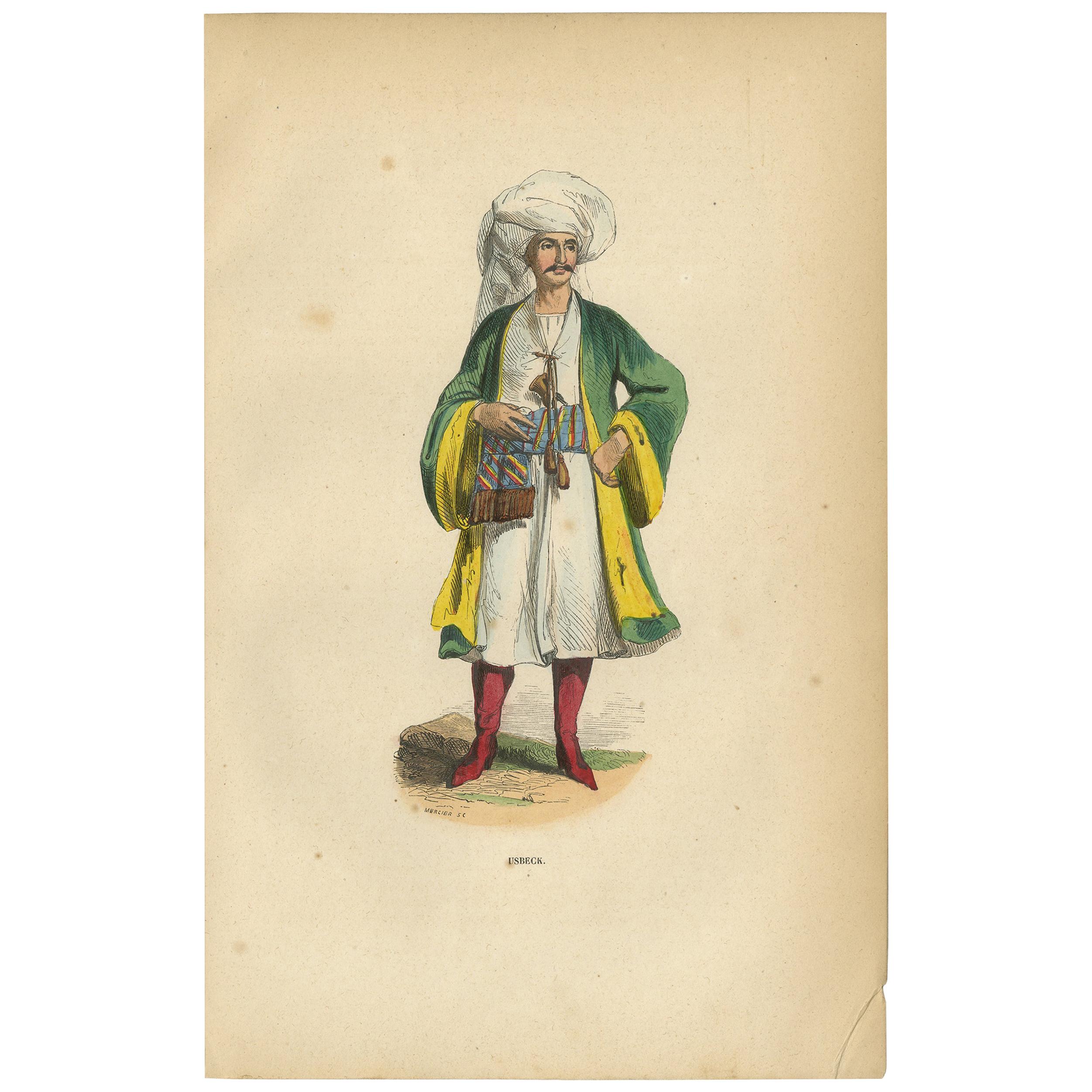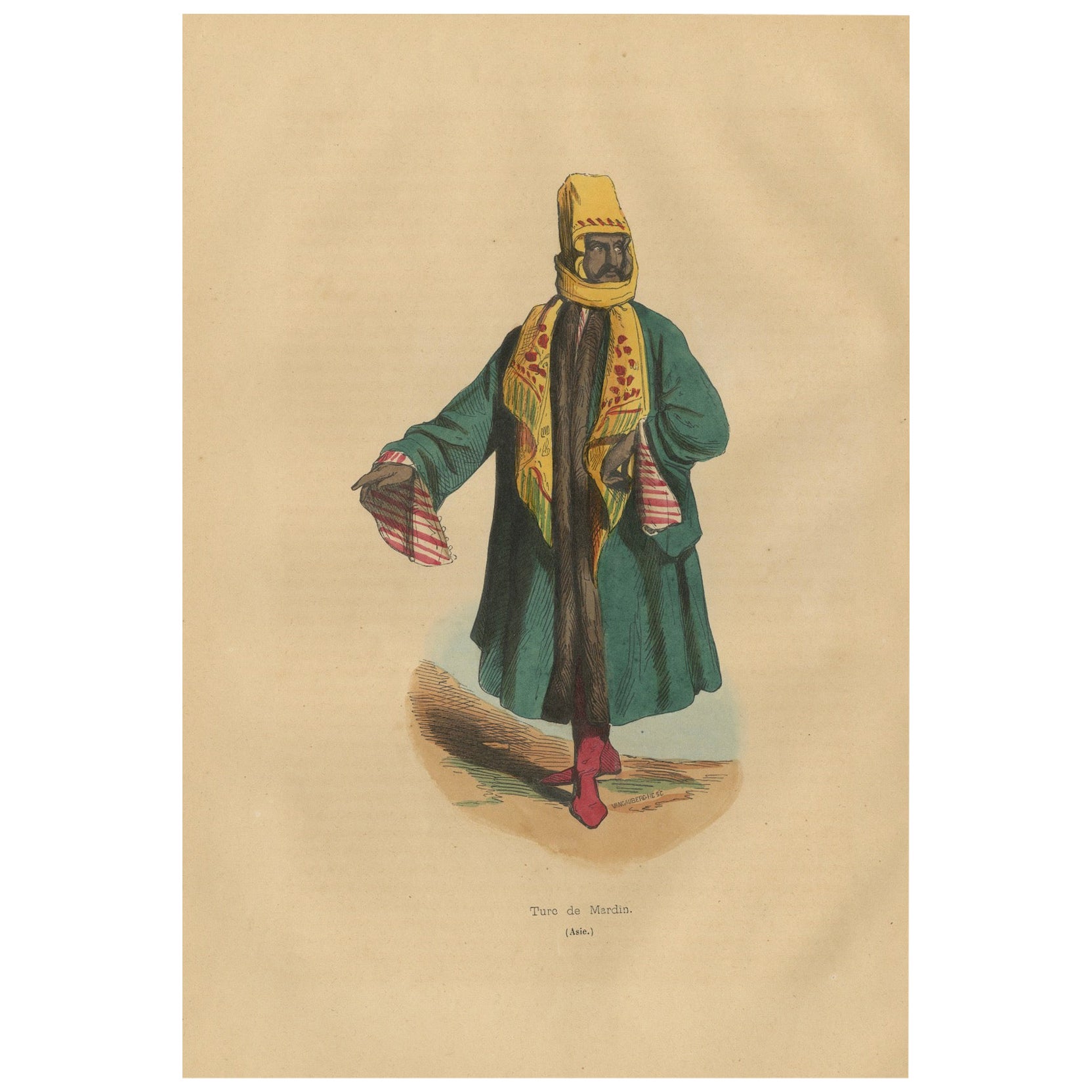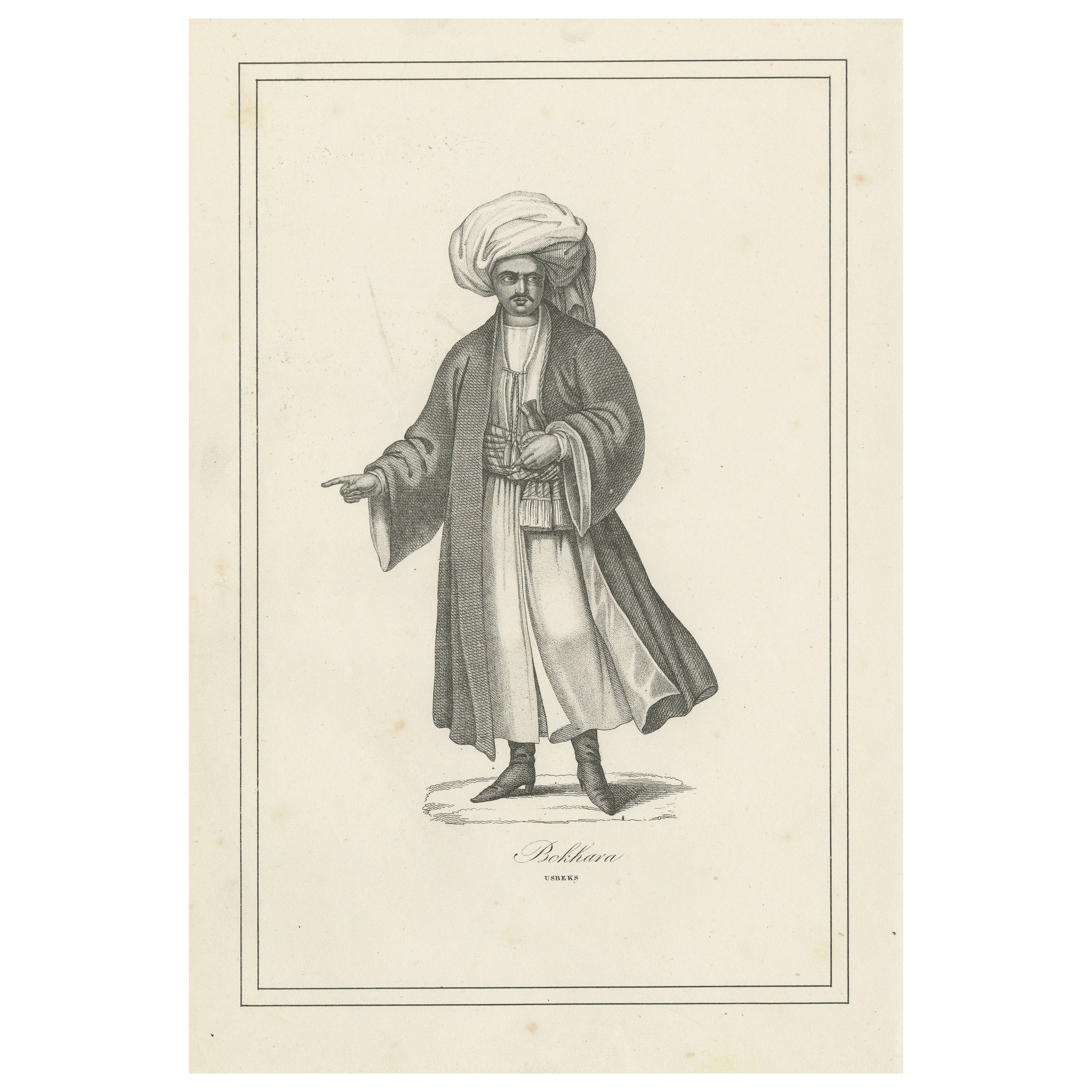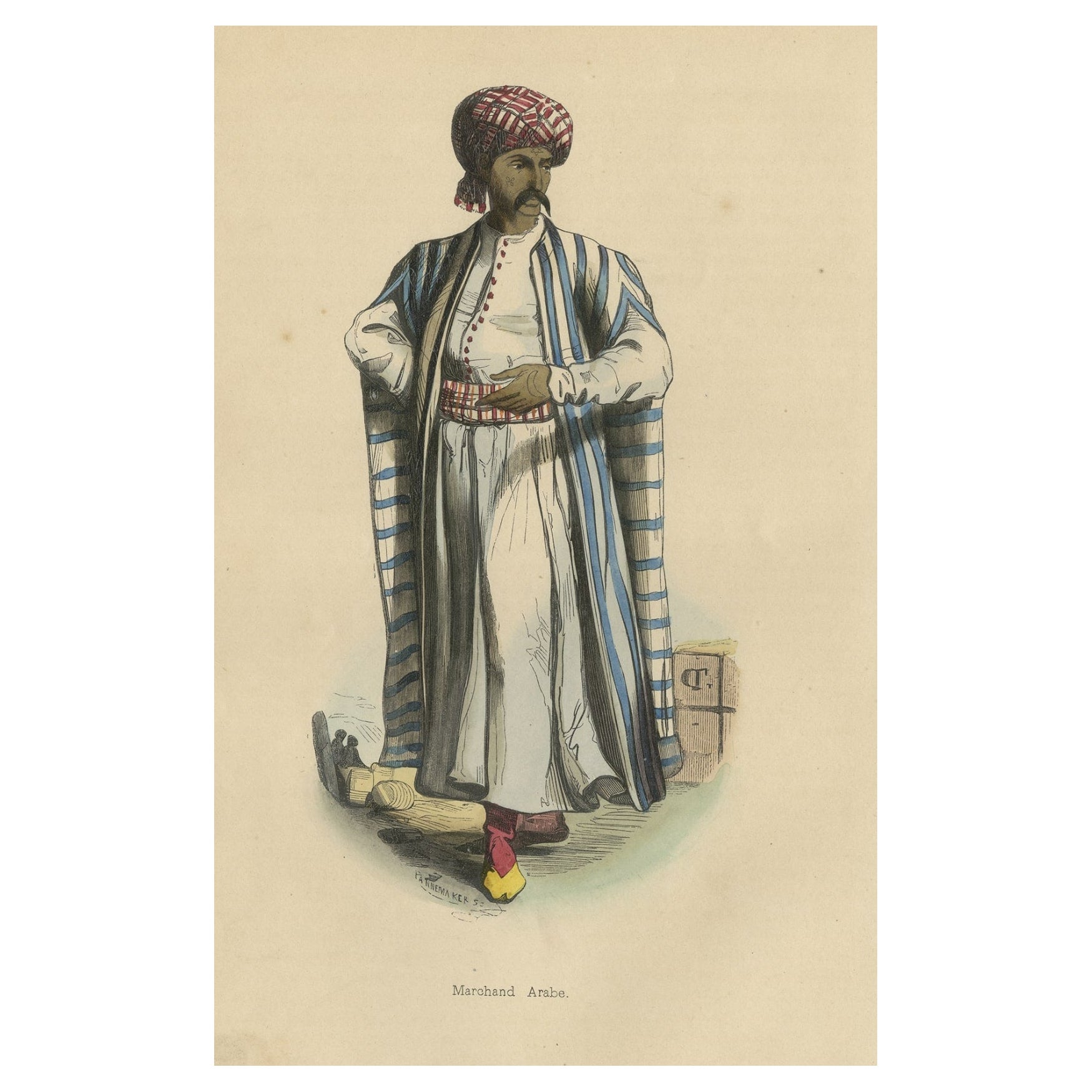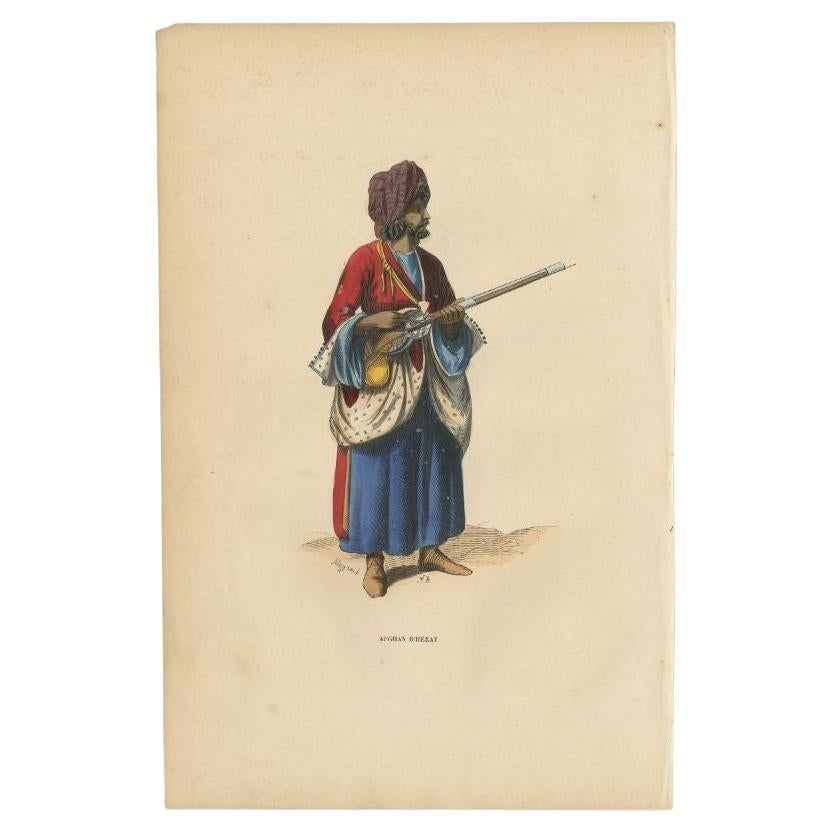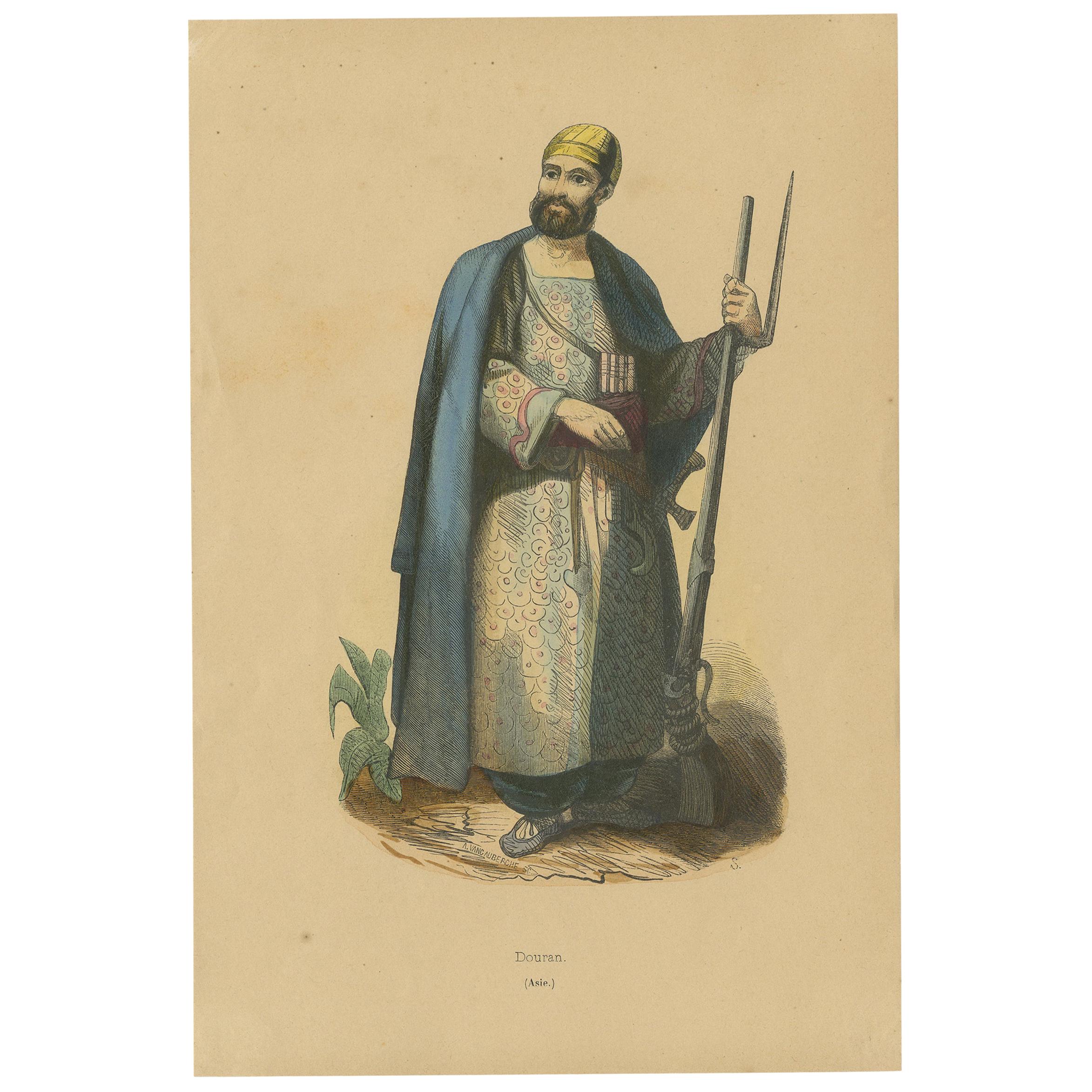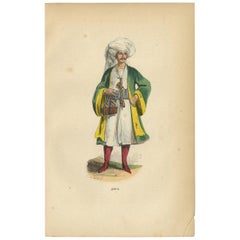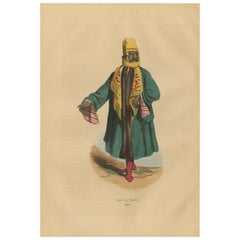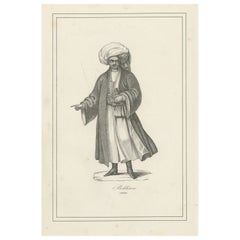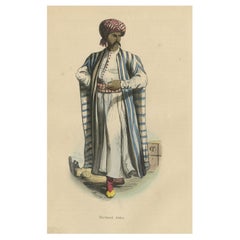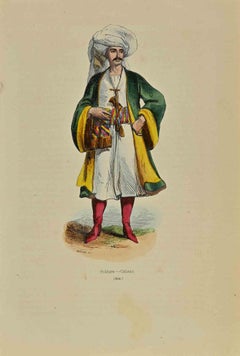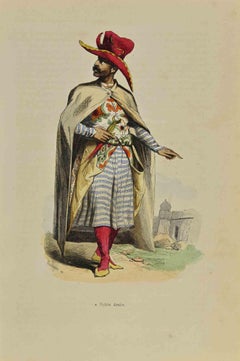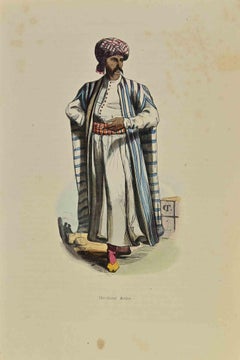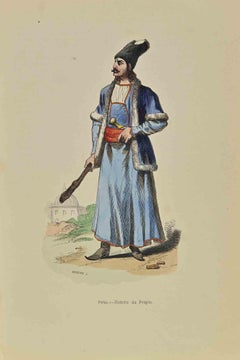Items Similar to 1844 Lithograph of a Bukharan Uzbek: Traditional Attire and Craft
Want more images or videos?
Request additional images or videos from the seller
1 of 6
1844 Lithograph of a Bukharan Uzbek: Traditional Attire and Craft
$142.86
$178.5720% Off
£106.18
£132.7320% Off
€120
€15020% Off
CA$197.25
CA$246.5620% Off
A$218.73
A$273.4220% Off
CHF 114.93
CHF 143.6620% Off
MX$2,672.54
MX$3,340.6820% Off
NOK 1,437.90
NOK 1,797.3820% Off
SEK 1,349.72
SEK 1,687.1520% Off
DKK 913.74
DKK 1,142.1720% Off
About the Item
"1844 Lithograph of a Bukharan Uzbek: Traditional Attire and Craft"
Description: This 1844 lithograph captures a traditional Bukharan Uzbek man, from the renowned series "Moeurs, Usages et Costumes de tous les Peuples de Monde" by Auguste Wahlen.
Published in Paris using the technique of handcoloured lithography, enhanced with Arabic gum on vellin paper, this print vividly portrays the rich cultural attire unique to Bukhara, Uzbekistan.
The man's elaborate robe and distinctive headwear highlight the regional fashion and craftsmanship. The print’s appeal lies in its detailed depiction of historical dress and accessories, offering a window into the cultural diversity of Central Asia. Such prints are treasured for their historical value and intricate artistry, making them highly desirable to collectors and enthusiasts of ethnographic art.
The lithograph depicting a man from Bukhara, Uzbekistan, offers several intriguing cultural and historical insights:
1. Traditional Attire: The attire of the Bukharan man, particularly the elaborate robe and turban, is a rich display of Uzbek textile craftsmanship. Traditional robes, often made from silk and cotton, are adorned with intricate ikat patterns—a dyeing technique where threads are dyed before weaving. This style is emblematic of Uzbekistan's well-known textile industry.
2. Turban Significance: The turban, known locally as a "doppa" or "tubeteika," is more than just practical headwear; it serves as a cultural symbol of status and identity. The style, color, and way it is worn can convey information about the wearer's social status, region, and even his clan affiliations.
3. Historical Context: Bukhara was a pivotal Silk Road city, making it a melting pot of cultures, languages, and religions. The diverse influences are reflected in the traditional clothing, which blends Persian, Turkic, and nomadic styles.
4. Artistic Technique: The use of handcoloured lithography in the 19th century allowed for high-quality, detailed prints that were more accessible to the European public. This technique involved drawing on limestone with a greasy medium, then using water and oil-based ink to print vibrant images, which were then painted by hand.
5. Cultural Preservation: Prints like this serve not only as artwork but also as historical documents that preserve and share the cultural heritage of regions less known to the Western world at the time. They played a crucial role in educating and influencing perceptions about distant cultures during the 19th century.
This print, therefore, is not just a beautiful piece of art but a deep well of cultural history and craftsmanship, reflecting the rich tapestry of life in Central Asia during the 19th century.
Keywords:
- Antique Uzbek prints
- Handcoloured lithography
- 19th-century Central Asian costumes
- Auguste Wahlen lithographs
- Traditional Bukharan attire
- Ethnographic art prints
- Collectible cultural lithographs
- Historical Uzbek fashion
- Asian historical prints
- Vintage Uzbek art
These keywords would be effective for anyone researching or interested in collecting prints that depict traditional Uzbek attire or seeking insights into the cultural heritage of Central Asia from the 19th century.
- Dimensions:Height: 10.12 in (25.7 cm)Width: 6.7 in (17 cm)Depth: 0 in (0.02 mm)
- Materials and Techniques:
- Period:
- Date of Manufacture:1844
- Condition:Condition: Good, given age. Faintly browned, and with some small stains. Some glue remains (from binding) in the far left margin (not affecting image). General age-related toning and/or occasional minor defects from handling. Please study the scans.
- Seller Location:Langweer, NL
- Reference Number:Seller: BG-12722-401stDibs: LU3054341384152
About the Seller
5.0
Recognized Seller
These prestigious sellers are industry leaders and represent the highest echelon for item quality and design.
Platinum Seller
Premium sellers with a 4.7+ rating and 24-hour response times
Established in 2009
1stDibs seller since 2017
2,609 sales on 1stDibs
Typical response time: <1 hour
- ShippingRetrieving quote...Shipping from: Langweer, Netherlands
- Return Policy
Authenticity Guarantee
In the unlikely event there’s an issue with an item’s authenticity, contact us within 1 year for a full refund. DetailsMoney-Back Guarantee
If your item is not as described, is damaged in transit, or does not arrive, contact us within 7 days for a full refund. Details24-Hour Cancellation
You have a 24-hour grace period in which to reconsider your purchase, with no questions asked.Vetted Professional Sellers
Our world-class sellers must adhere to strict standards for service and quality, maintaining the integrity of our listings.Price-Match Guarantee
If you find that a seller listed the same item for a lower price elsewhere, we’ll match it.Trusted Global Delivery
Our best-in-class carrier network provides specialized shipping options worldwide, including custom delivery.More From This Seller
View AllAntique Print of an Uzbek Man by Wahlen, 1843
Located in Langweer, NL
Antique costume print titled 'Usbeck'. Original antique print of an Uzbek man. This print originates from 'Moeurs, usages et costumes de tous les peuples du monde' by Auguste Wahlen.
Category
Antique Mid-19th Century Prints
Materials
Paper
$95 Sale Price
20% Off
Traditional Attire of a Man from Mardin in Turkey in 19th Century Lithograph
Located in Langweer, NL
Title: "Traditional Attire of a Man from Mardin in 19th Century Lithograph"
This lithograph, titled "Turc de Mardin," features a man from Mardin, a city in what is now Turkey. The i...
Category
Antique 1840s Prints
Materials
Paper
$133 Sale Price
20% Off
Antique Print of a Native of Bukhara, Uzbekistan
Located in Langweer, NL
Antique print titled 'Bokhara, Usbeks'. Original print of a native of Bukhara, Uzbekistan. Source unknown, to be determined. Published, circa 1880.
Category
Antique Late 19th Century Prints
Materials
Paper
$172 Sale Price
20% Off
Original Antique Print of an Arabian Merchant, 1843
Located in Langweer, NL
Antique costume print titled 'Marchand Arabe'.
Original antique print of an Arabian merchant. This print originates from 'Moeurs, usages et costumes de tous les peuples du monde'...
Category
Antique 1840s Prints
Materials
Paper
$133 Sale Price
20% Off
Antique Handcolored Print of an Afghan from Herat in Afghanistan, 1843
Located in Langweer, NL
Antique costume print titled 'Afghan d'Herat'. Original antique print of an Afghan from Herat. This print originates from 'Moeurs, usages et costumes de tous les peuples du monde' by...
Category
Antique 19th Century Prints
Materials
Paper
$133 Sale Price
20% Off
Antique Costume Print of an Arabian Man by Wahlen '1843'
Located in Langweer, NL
Antique costume print titled 'Douran'. Original antique print of an Arabian man. This print originates from 'Moeurs, usages et costumes de tous les peuples...
Category
Antique Mid-19th Century Prints
Materials
Paper
$95 Sale Price
20% Off
You May Also Like
Bokhara, Usbeks - Lithograph by Auguste Wahlen - 1844
Located in Roma, IT
Bokhara, Usbeks is a lithograph made by Auguste Wahlen in 1844.
Hand colored.
Good condition.
At the center of the artwork is the original title "Bokhara, Usbeks".
The work is pa...
Category
1840s Modern Figurative Prints
Materials
Lithograph
Noble Arab - Lithograph by Auguste Wahlen - 1844
Located in Roma, IT
Noble Arab is a lithograph made by Auguste Wahlen in 1844.
Hand colored.
Good condition.
At the center of the artwork is the original title "Noble Arabe".
The work is part of Sui...
Category
1840s Modern Figurative Prints
Materials
Lithograph
Arab Merchant - Lithograph by Auguste Wahlen - 1844
Located in Roma, IT
Arab Merchant is a lithograph made by Auguste Wahlen in 1844.
Hand colored.
Good condition.
At the center of the artwork is the original title "Marchand Arabe".
The work is part ...
Category
1840s Modern Figurative Prints
Materials
Lithograph
Persian, Man of the People - Lithograph by Auguste Wahlen - 1844
Located in Roma, IT
Persian, Man of the People is a lithograph made by Auguste Wahlen in 1844.
Hand colored.
Good condition.
At the center of the artwork is the original title "Perse. Homme du Peuple...
Category
1840s Modern Figurative Prints
Materials
Lithograph
Sultan Selim II - Original Lithograph - 1849s
Located in Roma, IT
Sultano Selim II is an original artwork realized by an Unknown artist in 1849.
Beautiful lithograph hand-watercolored on paper.
Good conditions. Titled on the bottom center. Delfin...
Category
1840s Modern Figurative Prints
Materials
Lithograph
Kurdish - Lithograph by Auguste Wahlen - 1844
Located in Roma, IT
Kurdish is a lithograph made by Auguste Wahlen in 1844.
Hand colored.
Good condition.
At the center of the artwork is the original title "Kurde".
The work is part of Suite Moeurs...
Category
1840s Modern Figurative Prints
Materials
Lithograph
